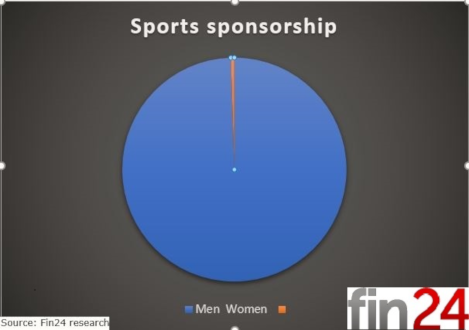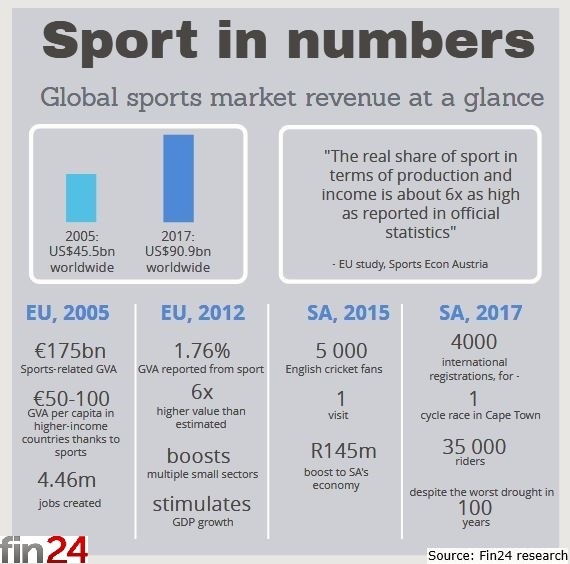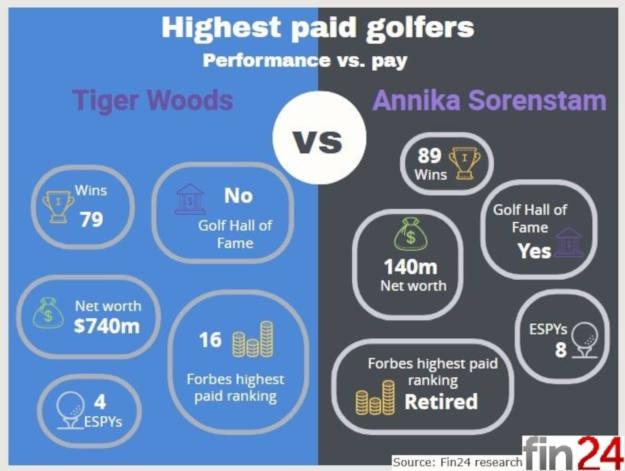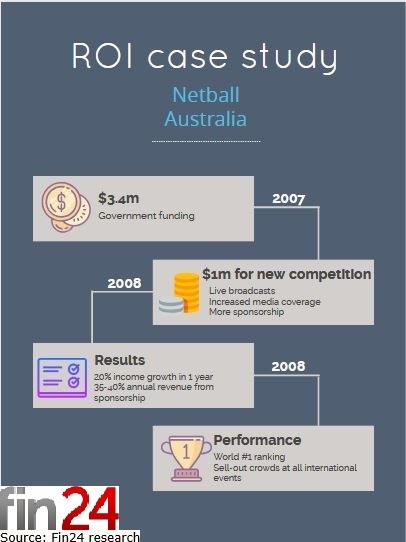Sport is big business, and not just for athletes.
But its economic impact is limited if much of the population is locked out. Busting myths about women's sport is not just good for athletes – it's good for sponsors, fans, and overall economic growth.
Myth 1: The pay gap isn't so bad
Though Serena Williams, with a net worth of $180m, tops Forbes list of richest female athletes, neither she nor any other woman appears on the current list of the top 100 highest-paid overall.
A 2016 study by BBC Sport argued the gender pay gap in sport was narrowing, and that of 44 sports that award prize money, 35 had begun to pay equally.
But that doesn't tell the whole story. The big money spinners – golf, cricket, football, for example – still have marked pay gaps, and over 99% of sponsorship goes to men's sport.
The global sports sponsorship market was worth $45bn in 2015. And for stars like Usain Bolt and Tiger Woods, sponsorship accounts for over 90% of their earnings.
Myth 2: Women's sport doesn’t generate enough ROI
A Commission on the Future of Women's Sport report found 0.5% of sponsorship went to women. Scant investment, scant returns.
"Women’s sport has been viewed, all too often, as an inferior version of its male counterpart, supposedly without the product, stars, audience or demand to generate sufficient ROI," the report read.
But the report's findings "tell a different story". Audience numbers, profile and perceptions and demand for women's sport suggested a "prime time to take a fresh look at an emerging market".
Myth 3: Men's sport has more fans
Sports writer Ewan MacKenna sums it up: "[B]roadcaster Fox brought in $17m in ad revenue from women's games in 2015, ESPN brought in $529m from the last men's tournament.
"That's all this really comes down to. You can't force the public to care. Name the fastest woman in the world? Name the women's number one tennis player? [P]ay is set by demand ... Plain and simple, women are relatively slower, lower, weaker."
Chicken, egg. Women's sport draws a fraction of the coverage men's sport does. Percentages quoted vary from 2% to a maximum of 7%.
Adweek.com found that in 2016, marketers for the Golden State Warriors reported a 13% increase in ROI over one NBA season just from increasing the team's presence on Instagram. It's marketing 101: visibility drives brand growth.
This is worth noting, because women's spending power is increasing. According to a report from Merkle and Levo, millennial women collectively represent a $170bn market. EY projected that by 2018, the global incomes of women would reach $18trn and drive 70–80% of all consumer purchasing.
Plus Sportswise found that 50% of women watched over three hours of sport per week, while Repucom Sports DNA says nearly half of women under 50 are interested or very interested in sport.
There's a major untapped market of fans waiting – who happen to be big spenders. Given existing global sports revenue, it's short-sighted not to explore that.
Myth 4: Men get paid better for performing better
For athletes of both genders, performance and pay can be inconsistent.
The gender pay gap, however, is constant, and the same old arguments to support it persist.
A couple of examples from debate.org: "They do less work. In weightlifting [women] don't even lift the same amount as men."
"Women are less physically gifted."
Actually, female athletes, due to their physical structure and muscle distribution, typically have to work a little harder.
But that aside, performance is relative.
Many know that in athletics, the typical performance gap between women and men is 10-12%, since speed and power are key measures. But not all sports are created equal; nor should performance be measured equally.
In weightlifting, certainly men typically lift more. But "work" is not measured numerically in weight lifted. Weight classes and the ratio of body weight to weight lifted is a factor in judging performance for both sexes precisely for this reason.
Bodybuilding, for its part, is notorious for deliberately limiting the performance of its female participants. In 1992, the IFBB introduced a series of "femininity" rules to the Ms Olympia contest; by 2005, mandatory 20% muscularity reductions were introduced for women deemed to require it.
As for golf, Anya Alvarez ran a 2017 gender-based performance analysis, questioning measures used. "It's tough to dispute that men are stronger and faster," she wrote, noting that the women on tour swung their drivers at an average of about 95mph, versus the men's average of 113mph.
Yet, she added, LPGA player So Yeon Ryu averaged 69.21 compared to Jordan Spieth’s 69.41 on the PGA, with comparable averages across both tours. Dana Finkelstein on the LPGA was ranked No1 in driving accuracy, hitting 88.2% of fairways, while her PGA counterpart, Steve Stricker, hit 72.85%.
What women lacked in power, they made up in skill and accuracy.
Myth 5: Women will get paid better when women's sport grows
Statistics on the gender pay gap across multiple industries is well-documented.
Within sport, it's not limited to athletes.
In various roles within the sports industry, from marketing managers to graphic designers, PayScale found a persistent pay gap. This was true regardless of whether the employees were working in men's or women's sport.
So even in men's sport, female employees were paid less, on average, for equal work.
Myth 6: Nothing can be done about it
Here's the good news. Where things are being done differently, it's working.
In South Africa, legislation supports advancing women and girls in sport, though researchers Nana Adom and Michelle Sikes believe more can still be done.
The South African Football Association has praised Banyana Banyana's consistently high performance, calling the senior team's 2012 Olympic qualification a pivotal moment. SAFA believes football offers "vital socio-economic relief" for women in SA, while the team's stellar performance has benefited the sport in terms of marquee sponsorships and funding.
Women's football is thriving abroad too. In June 2015, Specialist System Engineering (SSE) stuck a four-year deal with The Football Association to become the headline sponsor of the women’s FA Cup. The FA sees participation doubling by 2020.
Growth of the sport in the UK has been attributed to increased attendance by fans; social media marketing; campaigns and funding; strategic new signings; and more media coverage.
For golf, executives and sponsors have been targeting female audiences – and it paid off. In squash, reports Al Jazeera, a successful strategy was to merge tours and the men's and women's games as one package to broadcasters and sponsors.
The Women's Sports Foundation argues it's mostly social factors still holding girls and women back, particularly at grassroots level – where the crucial foundation is laid.
These are just a handful of examples. Where girls have positive role models, it makes a big difference.
And if sporting market revenue could double between 2005 and 2017 with minimal investment in half the population, think what could occur if that were changed.
Marelise van der Merwe is a journalist and sub-editor at Fin24. Views expressed are her own.
* Sign up to Fin24's top news in your inbox: SUBSCRIBE TO FIN24 NEWSLETTER




 Publications
Publications
 Partners
Partners



















